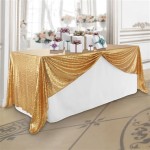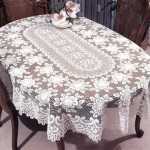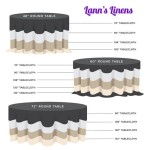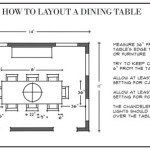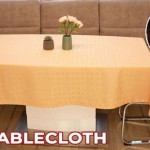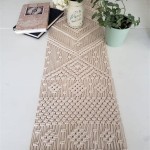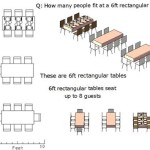How To Properly Use Tablecloths For Weddings
Tablecloths are a foundational element in wedding décor, contributing significantly to the overall aesthetic and ambiance of the celebration. They are more than mere coverings; they are a canvas upon which the entire tablescape is built. Understanding how to properly select, size, and style tablecloths is crucial for achieving the desired visual impact and creating a memorable dining experience for guests.
The effective use of tablecloths extends beyond simply draping fabric over a table. It encompasses considerations of material, color, texture, size, and layering techniques. Each of these factors plays a role in enhancing the overall elegance and sophistication of the wedding reception. Ignoring these details can result in a visually disjointed and less impactful event.
Therefore, a comprehensive understanding of tablecloth usage is imperative for wedding planners, designers, and anyone involved in the event's décor. This article will explore the key aspects of properly utilizing tablecloths for weddings, ensuring a polished and aesthetically pleasing result.
Selecting the Right Fabric and Material
The choice of fabric and material significantly impacts the look and feel of the wedding reception. Different fabrics possess varying levels of formality, durability, and visual appeal. Consider the overall theme and style of the wedding when making this decision. Factors such as the venue, the season, and the budget also play a role in determining the most appropriate material.
Linen is a popular choice for its classic elegance and natural texture. It drapes beautifully and adds a touch of sophistication to any table setting. However, linen wrinkles easily and may require professional laundering and ironing. It is often favored for rustic, bohemian, or classic wedding themes.
Polyester is a more budget-friendly option that is both durable and wrinkle-resistant. It is easy to care for and comes in a wide range of colors and finishes. Polyester is a versatile choice that can be used for formal or informal weddings, depending on the style of the tablecloth. It is a practical choice for large weddings where cost is a significant factor.
Satin offers a luxurious and glamorous look with its smooth, shiny surface. It is often used for formal weddings and adds a touch of opulence to the table setting. Satin can be delicate and may require special care. It is suitable for creating a high-end and elegant dining experience.
Cotton is a versatile and comfortable fabric that is suitable for both formal and informal weddings. It is durable, easy to care for, and comes in a variety of colors and patterns. Cotton is a good choice for outdoor weddings or weddings with a relaxed and casual atmosphere.
Beyond these common choices, consider specialty fabrics like lace, velvet, or sequined materials for accent tablecloths or overlays. These materials add texture and visual interest to the table setting and can be used to complement the overall wedding theme. They are best used sparingly to avoid overwhelming the design.
Determining the Appropriate Tablecloth Size and Drop
Properly sizing the tablecloth is crucial for achieving a polished and professional look. An incorrectly sized tablecloth can detract from the overall aesthetic and create an awkward or unbalanced visual impression. It is essential to measure the tables accurately and calculate the appropriate tablecloth dimensions to ensure a perfect fit.
The "drop" refers to the amount of fabric that hangs over the edge of the table. A standard drop typically ranges from 12 to 18 inches. This length creates an elegant and balanced look without being overly long or cumbersome. A drop of less than 12 inches may appear too short, while a drop longer than 18 inches may be impractical and potentially hazardous.
To calculate the appropriate tablecloth size, add twice the desired drop to the table's dimensions. For example, if a round table is 60 inches in diameter and a 15-inch drop is desired, the tablecloth should be 90 inches in diameter (60 inches + 15 inches + 15 inches = 90 inches). This calculation ensures that the tablecloth drapes evenly around the table.
For rectangular tables, the same principle applies. Measure the length and width of the table and add twice the desired drop to each dimension. For instance, if a rectangular table is 48 inches wide and 72 inches long, and a 12-inch drop is desired, the tablecloth should be 72 inches wide and 96 inches long (48 inches + 12 inches + 12 inches = 72 inches; 72 inches + 12 inches + 12 inches = 96 inches).
Consider the type of table being used when determining the drop. For buffet tables or head tables, a longer drop may be preferred to create a more dramatic and impactful look. Conversely, for cocktail tables or smaller tables, a shorter drop may be more appropriate. The goal is to achieve a balanced and aesthetically pleasing proportion between the table and the tablecloth.
Always double-check measurements and consider ordering a sample tablecloth to ensure the desired fit and appearance. This step can prevent costly mistakes and ensure that the tablecloths enhance the overall décor of the wedding reception.
Styling and Layering Tablecloths for Visual Impact
Beyond selecting the right fabric and size, styling and layering tablecloths can elevate the visual impact of the table setting. Layering different colors, textures, and patterns can create depth and dimension, adding complexity and visual interest to the overall design. This technique allows for greater customization and personalization of the wedding décor.
Consider using a base tablecloth in a neutral color, such as white, ivory, or gray, to provide a foundation for the table setting. This base tablecloth should be sized appropriately to achieve the desired drop. The neutral color allows for greater flexibility in layering other colors and patterns without clashing or overwhelming the design.
An overlay, often a smaller tablecloth placed on top of the base tablecloth, can be used to introduce color, texture, or pattern. Overlays can be made of a different fabric than the base tablecloth, such as lace, satin, or a patterned material. The size of the overlay should be proportionate to the table and the base tablecloth, typically covering the center of the table or running as a runner down the center.
Table runners are a versatile option for adding visual interest and defining the center of the table. They can be used on their own or in conjunction with a base tablecloth and overlay. Runners can be made of various materials, including fabric, burlap, or even natural elements like greenery or flowers. They provide a focal point and help to tie the table setting together.
Consider using placemats or chargers to further enhance the table setting. These elements provide a visual break between the tablecloth and the tableware, adding another layer of texture and color. Placemats and chargers can be made of various materials, such as fabric, metal, or wood, and should complement the overall style of the wedding.
The use of accessories, such as ribbons, sashes, or decorative clips, can add a personal touch to the tablecloths. These elements can be used to cinch the tablecloths at the corners or to add a decorative detail along the edges. Carefully chosen accessories can enhance the overall elegance and sophistication of the table setting.
When layering tablecloths, consider the color palette of the wedding. Choose colors that complement each other and create a cohesive look. Avoid using too many colors or patterns, as this can result in a visually cluttered and overwhelming design. The goal is to create a balanced and harmonious table setting that enhances the overall ambiance of the wedding reception.
Ultimately, the proper use of tablecloths for weddings involves careful consideration of fabric, size, and styling. By paying attention to these details, it is possible to create a stunning and memorable dining experience for guests.

Wedding Linens Where To Buy Or What Know

Your Guide To Wedding Reception Linens

How To Keep Tablecloths Wrinkle Free Cv Linens

Wedding Wednesdays Q A Floor Length Tablecloths

The Ultimate Guide To Designing Your Wedding Reception Total Events Llc

Ivory Vs White Tablecloths Table Linens Best Wedding Choices Tablecoversnow Com

5 Tips For Choosing Wedding Table Linens Lakes Region Tent Event

Love In Full Bloom Colorful Spring Wedding Ideas Southern Events Party Al Company Franklin Nashville Middle Tennessee

What Is A Table Overlay Cv Linens

Choosing The Perfect Wedding Linens Color Schemes Expert Advice
Related Posts

